Sons of Speed 2023 gets massive attendance
By Wayfarer |
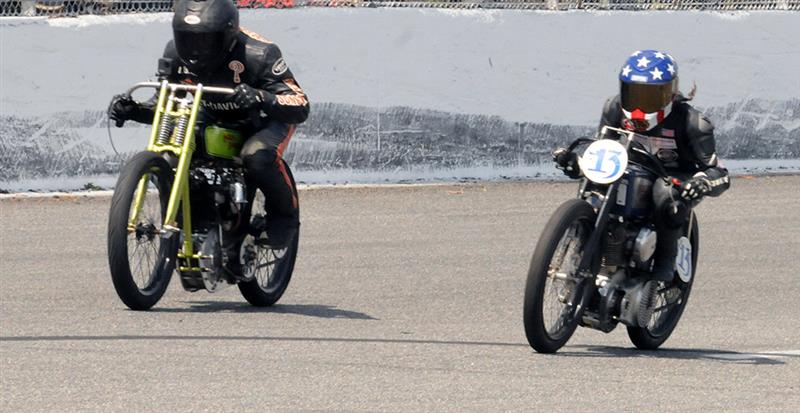 by Rogue – Misled – Christy
Sons of Speed 2023 has started Bike Week Off With Record Attendance
Sons of Speed has always been an enjoyable event for me to attend and cover. I really like that people have taken the time to keep these classic motorcycles running and even more to the point, actually racing them. This event is exploding.
I am not the only one who feels that way, the event was packed. Attendance was up and so were the new classes and number of riders racing.
by Rogue – Misled – Christy
Sons of Speed 2023 has started Bike Week Off With Record Attendance
Sons of Speed has always been an enjoyable event for me to attend and cover. I really like that people have taken the time to keep these classic motorcycles running and even more to the point, actually racing them. This event is exploding.
I am not the only one who feels that way, the event was packed. Attendance was up and so were the new classes and number of riders racing.
Click here to read the wonderful photo feature report only on Bikernet.com
* * * * * * * * * * * * * * * *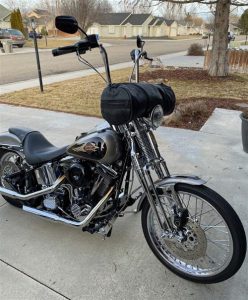
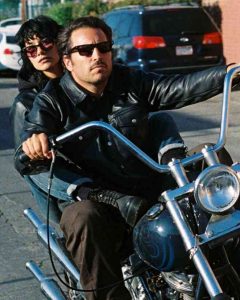
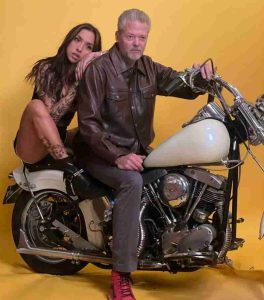
Gear up to ride to your favorite Motorcycling Events – Click Here to view the all-new 5-Ball Racing Shop
Motorcycle Riders Foundation: Coalitions Rejuvenated
By Wayfarer |
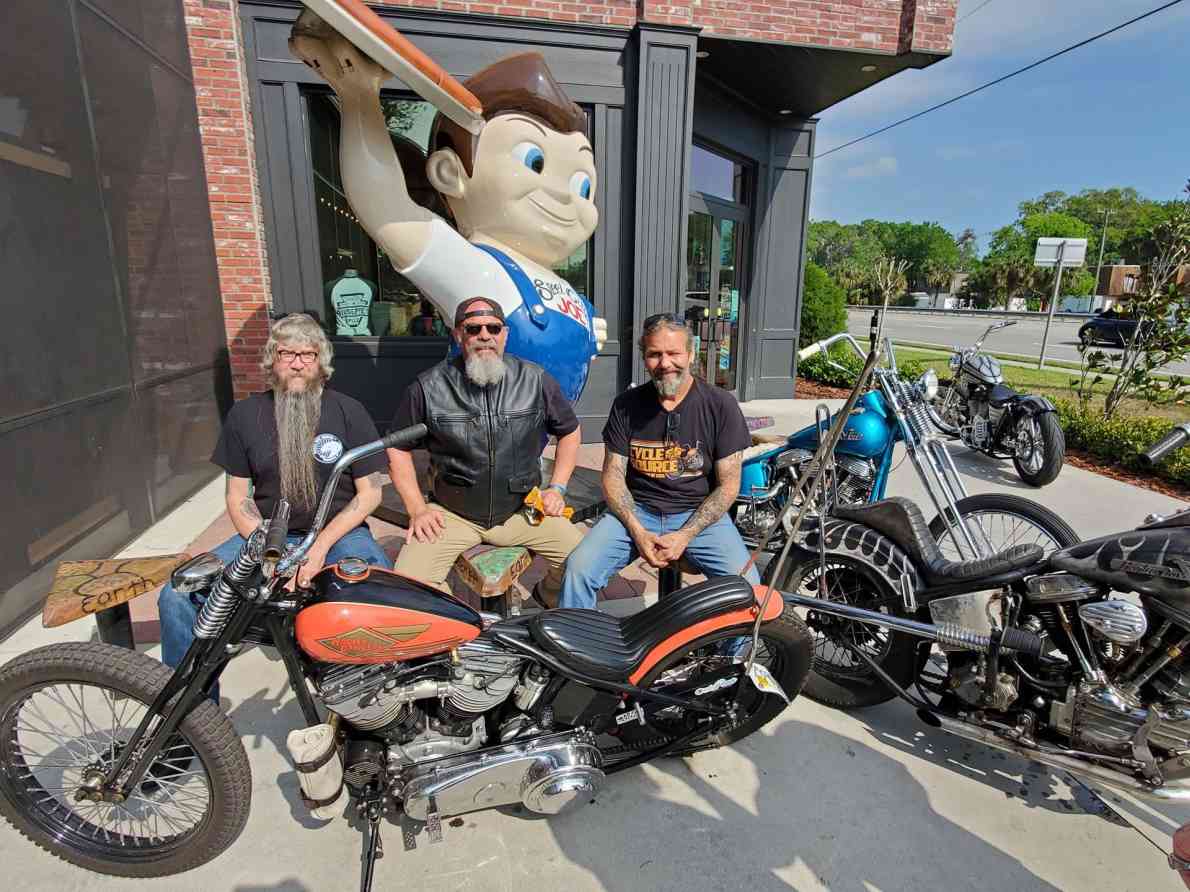
The Motorcycle Riders Foundation (MRF) 2023 legislative agenda includes a diverse set of issues that strike at the core of who we are as bikers.
Historically, the MRF has fought many battles to defend individuals and the aftermarket motorcycle businesses’ rights to customize and repair motorcycles. Our successful defense against the EPA’s “Color and Chrome” only initiative and the regulations/enforcement related to it helped define the MRF and what we stand for to this day.
The MRF has long supported the Recognizing the Protection of Motorsports Act (RPM Act), which would ensure that modifying motor vehicles into racing vehicles used for competition would not violate the Clean Air Act. We anticipate an updated version of the RPM Act will be introduced this Spring. The MRF and our partners will work diligently for passage of this commonsense piece of legislation. Importantly, some of these parts and technology we are looking to protect are used in the EPA allowances for one-per-lifetime custom bikes and Tier 1 eligible motorcycles we fought for two decades ago.
The MRF agenda also strongly supports the desire to protect a consumer’s right to repair, and ownership of data related to their vehicles. A recently introduced bill, H.R. 906 The Repair Act, helps protect consumers’ ability to utilize independent repair shops and aftermarket parts to work on vehicles, including motorcycles.
These issues are becoming increasingly important and drawing the attention of the aftermarket industry and bike customizers. The EPA has restarted a campaign of increased enforcement and it is threatening shops and individuals with legal action.
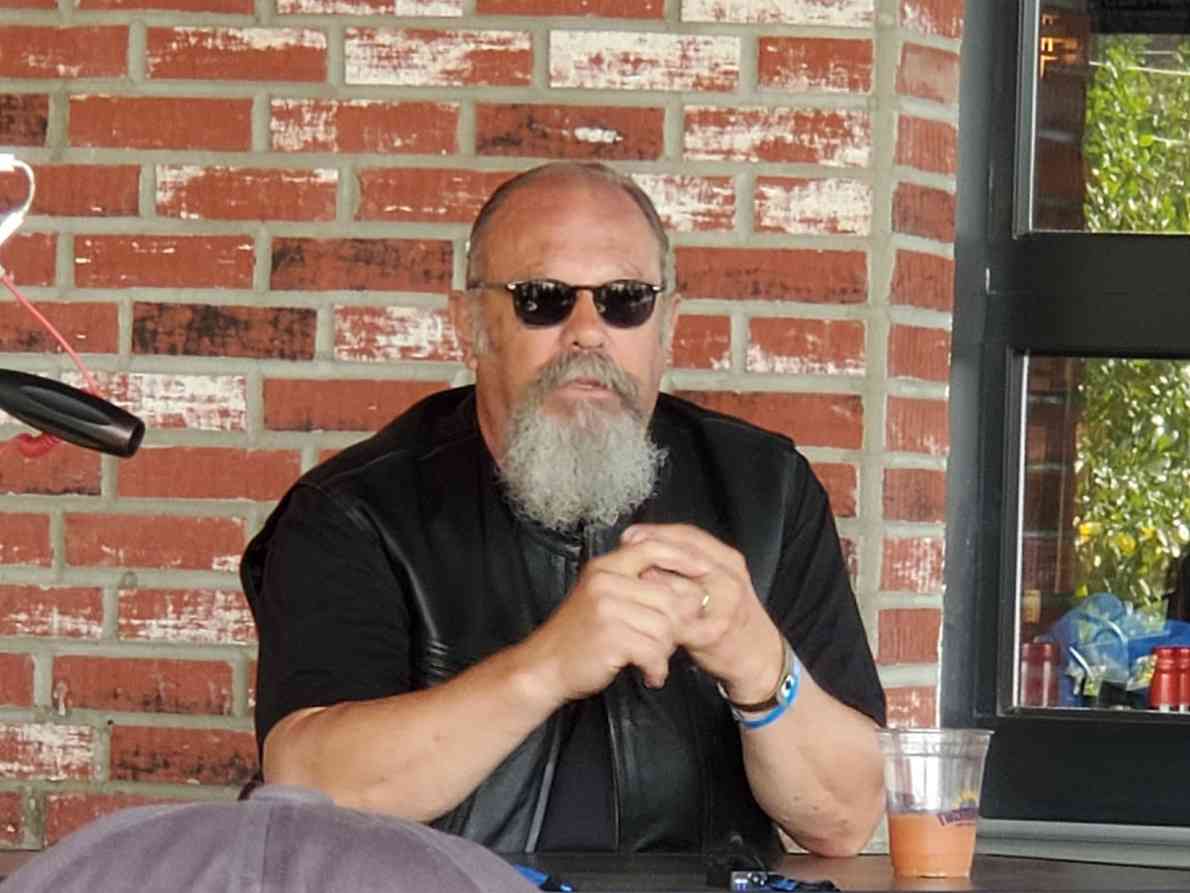
MRF President Kirk “Hardtail” Willard recently appeared on Cycle Source Magazines “Shop Talk” radio show to discuss these issues and this week traveled to Daytona Bike Week to join independent motorcycle shop owners and others in the aftermarket industry to discuss the many issues facing this industry. The meeting was hosted by Chris Callen of Cycle Source Magazine and moderated by industry icon Bob Kay. Hardtail had this to say about the meeting, “It was encouraging to see both the level of concern and willingness in this group to engage in our efforts and educate other players in the aftermarket industry.”
The MRF won’t tackle these challenges alone, we are aggressively looking to put back together our coalition that was so effective in past battles. In the past the coalition included, the aftermarket industry, media and print publications, other custom vehicle organizations, and other motorcyclists’ rights groups. Lastly, our Master Mechanic and technical expert Dave “Dad” Dwyer is looking to schedule a meeting with the EPA in Detroit to discuss our growing concerns.
These are challenging issues, but with your continued support and the help of other like-minded advocates we will fight to defend the rights and freedoms we cherish.
Dawn Riba
Motorcycle Riders Foundation Communications Director
* * * * * * * * * * * * * * * *
Follow Freedom and Rights News on Bikernet.com at:
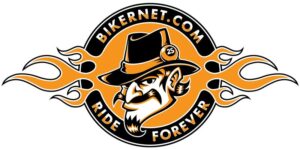
Indian Motorcycle Racing Leads National Championship
By Wayfarer |
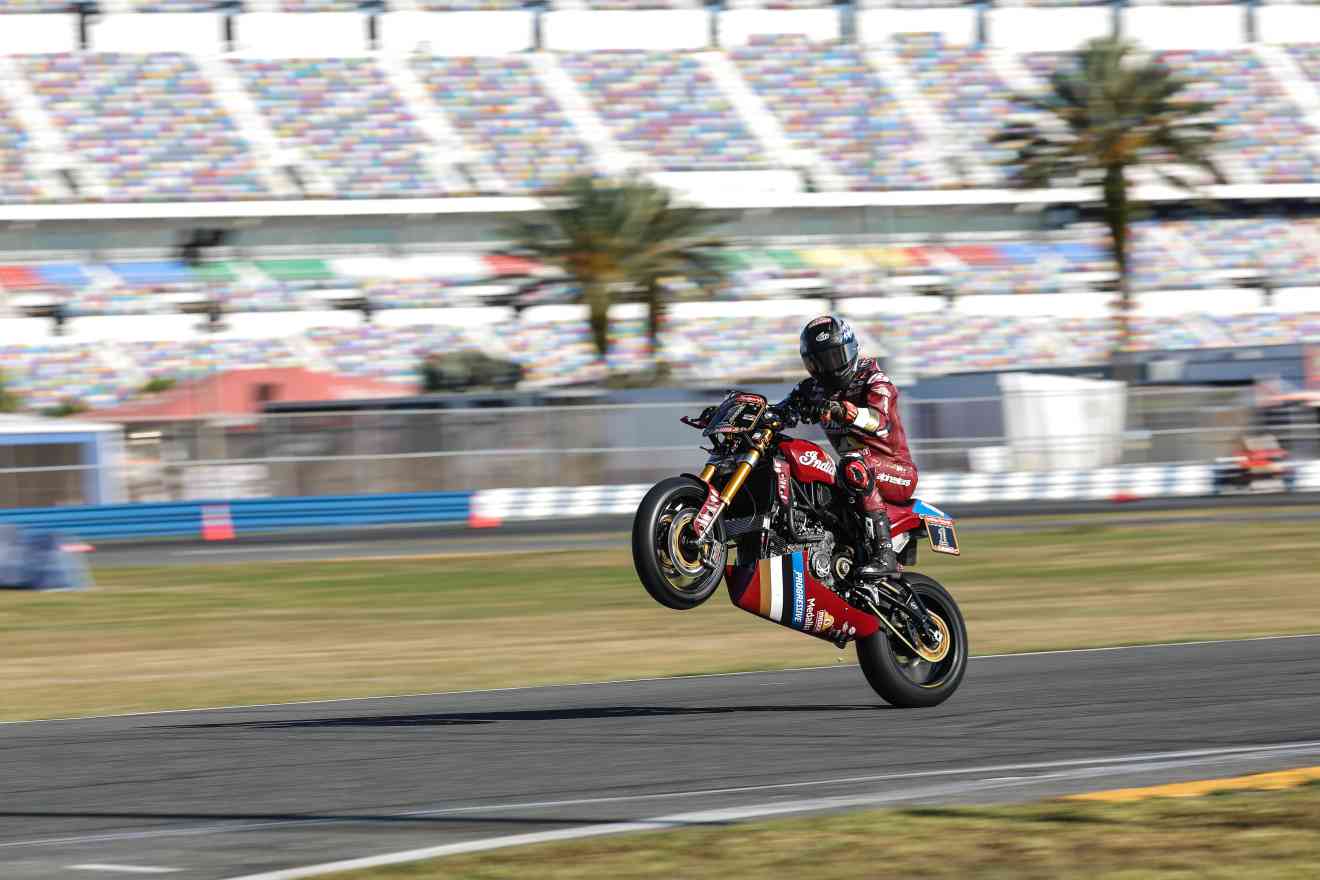
INDIAN MOTORCYCLE RACING LEADS MISSION® SUPER HOOLIGAN® NATIONAL CHAMPIONSHIP FOLLOWING SEASON OPENER AT DAYTONA INTERNATIONAL SPEEDWAY
2022 Super Hooligan® Champion Tyler O’Hara Takes Early Points Lead Following Back-to-Back Wins At Daytona Doubleheader
Indian Motorcycle Racing Comes Away with Podium Finish in Mission® King of the Baggers,
O’Hara Ranks Fifth In Season Standings with 21 Points, McWilliams Eighth with 19
MINNEAPOLIS (MARCH 14, 2023) – Following an offseason that expanded the competitive landscape with new manufacturers lining up for the MotoAmerica® Mission® Super Hooligan® National Championship (SHNC), it was Indian Motorcycle Racing and its factory team claiming the top two spots on the leaderboard, following the season-opening doubleheader at Daytona International Speedway. Piloting a pair of S&S®-built Progressive® Mission® Foods Indian FTRs, reigning SHNC champion Tyler O’Hara and teammate Jeremy McWilliams each left Daytona with a pair of podiums, including back-to-back victories for O’Hara and third and second-place finishes for McWilliams.
On Friday, March 10, O’Hara strategically tailed RSD Indian FTR privateer Bobby Fong for nearly the entire six-lap race. Waiting for the final lap to strike, O’Hara was able to carry more speed through the chicane and go up and around the outside of Fong to capture the season’s first win by .0064 seconds. McWilliams rounded out the podium to complete the Indian FTR podium sweep.
“Bobby was running fast all weekend and gapped me for a period until I was able to make up some ground. The lapper through the chicane definitely played a big role as I wasn’t sure if I was going to be able to draft pass him on the finish,” said O’Hara. “But what a fun race, and for Indian Motorcycle to sweep the podium just shows how impressive this Indian FTR really is.”
Race 2 on Saturday, March 11, was filled with plenty of action. After an early crash caused a red-flag restart, it was a five-rider group at the front of the pack. Pushing hard in the group, KTM rider Andy DeBrino lost his front end and laid his bike down, while Fong encountered a technical issue – making it a three-rider run for first between Harley-Davidson rider Corey West, O’Hara and McWilliams. While West ultimately crossed the finish line first, a post-race bike inspection found an illegal air intake that resulted in a disqualification – awarding O’Hara his second win of the weekend and earning McWilliams a second-place finish.
In the MotoAmerica® Mission® King of the Baggers (KOTB) class, O’Hara reached the podium with a third-place finish in Race 1. While the Indian Challenger had been running fast all weekend, even clocking the weekend’s fastest speed on a bagger at 182 mph, both O’Hara and McWilliams suffered technical issues in Race 2. Indian Motorcycle Racing concluded the opening rounds at Daytona with O’Hara in fifth (21 points) and McWilliams in eighth (19 points) on the season’s leaderboard.
“Our issues this weekend were specifically with our tires, MotoAmerica is a spec tire series, we are only given one choice for tires for Daytona and they failed with our higher speeds after four laps, but our new bikes are performing incredibly well, with a significantly higher level of both handling and power, as evidenced by both our riders registering speeds of more than 180 mph throughout the weekend,” said Gary Gray, Vice President – Racing, Technology and Service for Indian Motorcycle. “At the end of the day, the performance of our Indian Challengers, coupled with our success in the Super Hooligan class has us feeling extremely optimistic and incredibly motivated heading into the second round in Atlanta.”
The 2023 KOTB and SHNC seasons continue with Road Atlanta April 21-23. For more information visit MotoAmerica.com.
Indian Motorcycle Racing is presented by Progressive Insurance®, Mission® Foods and Medallia®, with additional support from Indian Motorcycle Motor Oil, S&S®, Parts Unlimited, Drag Specialties®, Performance Finance, and J&P Cycles®.
For information about Indian Motorcycle, visit IndianMotorcycle.com, or follow along on Facebook, Twitter and Instagram.
* * * * * * * * * * * *
Catch all the action with a free weekly newsletter from Bikernet Blog. Click & Go !

SONS OF SPEED 2023
By Bikernet Contributor Rogue |

Sons of Speed has always been an enjoyable event for me to attend and cover. I really like that people have taken the time to keep these classic motorcycles running and even more to the point, actually racing them. This event is exploding

I am not the only one who feels that way, the event was packed. Attendance was up and so were the new classes and number of riders racing.


Races have several different classes for types of engines.



https://www.youtube.com/watch?v=EfNG48LwU6o



I ended up in Shelly Rossmeyer’s Pit watching Berry Wardlaw, Chuck Kennedy and Rebel Glover keep her bike running in top condition. Prior to the race Shelly’s bike went to Berry’s shop Accurate Engineering in Dothan, Alabama for tuning and runs on the new racing dyno he recently installed. They found some problems, when running on the dyno, fixed them and the end result is her bike ran the best it has ever performed.
While the races are the big thing, it was also a time to see friends and get to spend some time with them and catch up


Chris Callen, the emperor of Cycle Source was in the pits next to us. He’s gone from helping with the races to working the pits and this year entered a bike. He ran 28 second laps and won a couple of heats and made the main event. He’ll be back.








In the final race of the day Moonshiner Josh Owens crashed coming out of turn 3 and received serious injuries and was taken to the hospital in an ambulance.
At the time of this writing he is recovering. Friend and brother racer Freddie Bollwage reported on his condition.
Josh has two broken legs, both kneecaps, ankle, broken neck and lower back injury. He had surgery and is alert and doing well considering the extent of his injuries. There was no head trauma or internal bleeding.
Freddie thanked everyone for their prayers. Please keep them coming.
There will be a Go Fund Me set up in the near future to help with the hospital expenses and recovery. We will keep you informed as we get more information,


https://www.facebook.com/thesonsofspeed/
I’ll be back next year, can’t miss it!
Five Motorcycles for Daily City Commute
By Wayfarer |
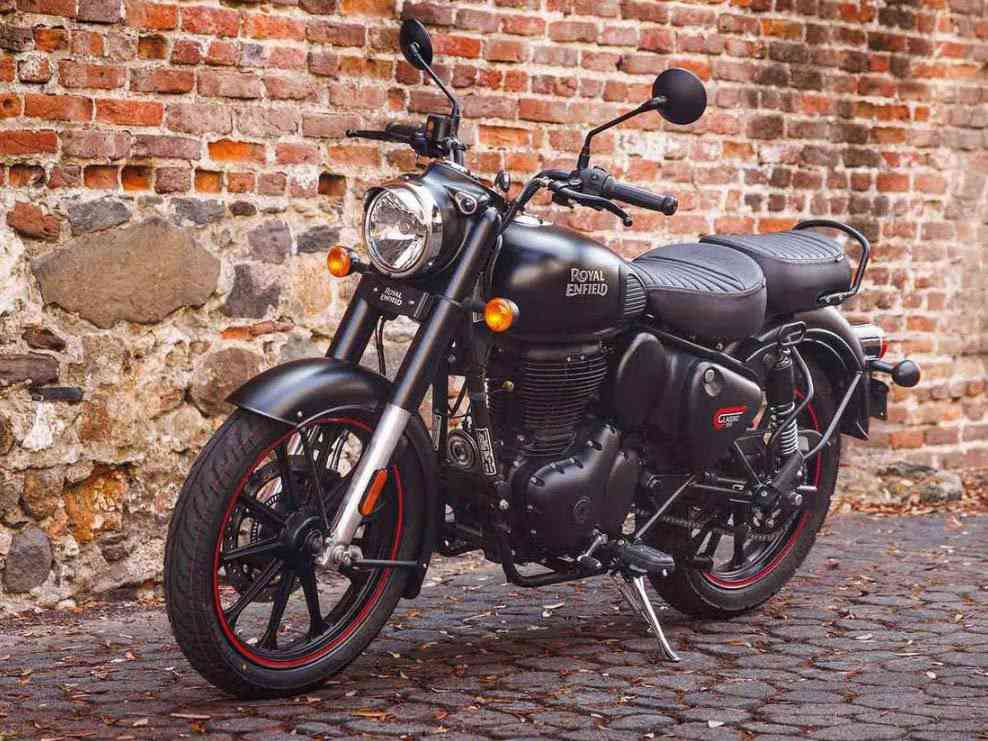
Despite rising inflation in 2023, there are still cool new motorcycles under $5,000
-
2023 Honda Monkey: $4,249
-
2023 Honda Rebel 300: $4,749
-
2023 Kawasaki KLX230: $4,999
-
2023 Royal Enfield Classic 350: $4,799
-
2023 Yamaha MT-03: $4,999
Bikers Meet The Old West In New Adventure Fiction
By Wayfarer |
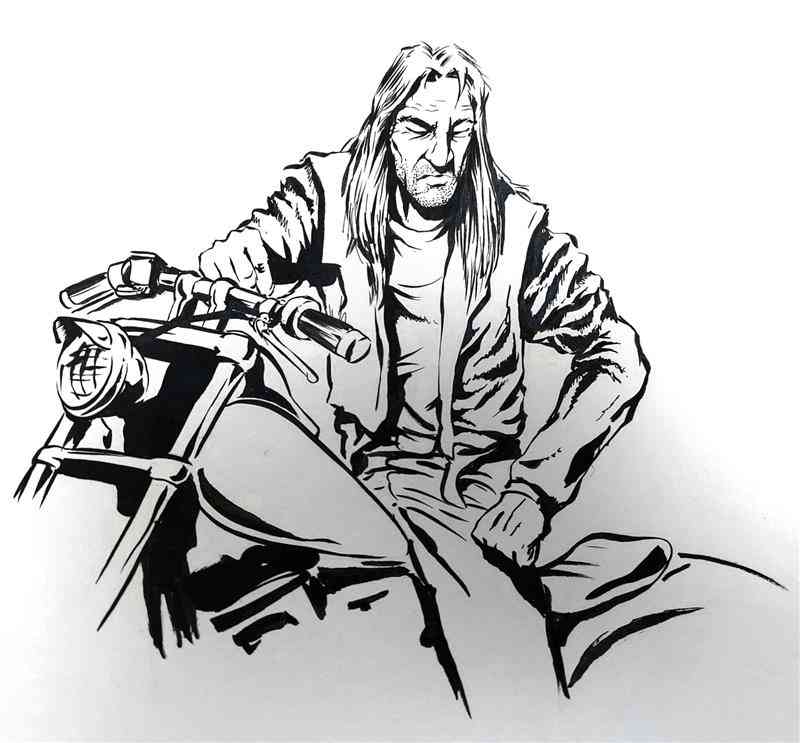
by K. Randall “Bandit” Ball
The city from Laguna to Irvine and El Toro closed in on Trabuco Canyon like a concrete plaque. But Cook’s still resided in the last remaining unencumbered scrub hills. Bruno tied off his helmet to his TT bars and kicked up dust in the ground-shale parking lot to the door. It was wide, thick planks and swung open with a rusting creak. Dark inside the Four Tops played Only the Lonely from the neon jute box.
But something foreboding filled the air. Straight ahead was the bar and a number of club members scrambling around something or someone on the floor.
Click here to read the latest biker fiction from the master of the genre only at Bikernet.com
* * * * * * * * * * * *
Visit Bandit’s Cantina for entire novels, click here.
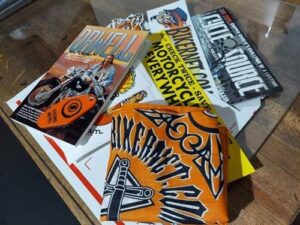
Bruno is Coming
By Bandit |

Editor’s Note: We are having some fun with the notion that bikers may become the cowboys of the future. So, we took liberties with a movie from 1974 with Burt Lancaster, called Valdez is Coming. Watch for the final chapter in April 2023.
The city from Laguna to Irvine and El Toro closed in on Trabuco Canyon like a concrete plague. Cook’s resided in the last remaining unencumbered scrub hills. Bruno tied his helmet to his bars and stepped up to the entrance. The door cried in pain as he pushed it open. The inside smelled of sawdust, tobacco smoke, and beer. The Four Tops’ “Only the Lonely” played on the juke. Straight ahead was the bar. In between, six Comancheros M/C members kicked the shit out of someone on the floor.
“What the fuck?” Bruno approached the melee on the slat floor scattered with cigarette butts, peanut shells and dust. He yanked one rider from the rat pack to see a black motorcyclists on the wooden deck bloodied and desperately trying to protect himself.
“That’s enough,” Bruno said. “Let the kid go.”
A big Hispanic with massive arms stepped up. Meaner than cat shit, he glared at Bruno and spit on the deck. “What the fuck is it to you? He stole a club bike. He pays.”
Bruno looked down at the battered kid on the deck, who shook his head tearfully through blood and spit and muttered, “I never stole a motorcycle.”
Bruno looked back at Pablo the club VP with tattoos running up his neck and one on his temple. “Did you get the bike back?”
“That’s none of your fucking business puto,” Pablo snapped as nasty as a stepped on rattlesnake.
“Pick him up,” Pablo ordered and the brothers hauled the black rider to his feet.
“I ride a sport bike,” the rider said through bloody teeth under a crushed nose.
Pablo spun in the direction of the young man in the darkened bar. He pulled a shiny 12-inch, straight blade and buried it into the abdomen of the kid just below his ribs and twisted the blade. The African American youngster gasped and stared wide-eyed. Pablo wiped the bloody knife on the kid’s t-shirt as he took his last breath. “Drop him, let’s ride.”
Pablo stepped up, the knife reflecting from the dim barroom lights and neon. He wasn’t much taller than Bruno, but big and buffed. “That was your fault, don’t interrupt,” he muttered his voice low and gravely.
Bruno watched the knife. He was too close, but the big man put it away and then shoved Bruno hard. Bruno stumbled and knocked over a table as he hit the deck. Before he could get to his feet, he was surrounded by Comanchero brothers some reaching for weapons.
A tall white member sporting a Prez patch sewn over his leather vest pocket, stepped through the crowd and put his arm around Pablo as he stared down at the redheaded white boy. “You don’t want to mess with my brothers. As you can see, if some sonuvabitch steals one of our bikes, we don’t fuck around. Let’s ride brothers. Nobody messes with the Comancheros.”
Bruno quickly jumped to his feet as the members jammed to the parking lot, fired up their bikes and rode out. He made his way to the bar and ordered a Jack on the Rocks as the young girl dove to the side of her boyfriend weeping and holding him in her slender arms.
Bruno took his drink to her table, sat and watched for a moment. Other patrons tried to console the young girl. The bartender called 911. Bruno didn’t want to be there when the cops arrived.
Shaken, he downed the whiskey, stood and headed for the door. Outside, he unhooked his helmet and suddenly the girl was as his side. Mexican, she had warm features and he studied her for the first time. Under the vague, distant, parking lot lights, her features glowed like a camp fire, beautiful, partially because of her pregnancy. He look down at her stomach.
“What am I going to do now?” Sheila said and ran her slender hand over her baby bump. “He never stole anything. It’s my fault. My ex was a Comanchero.”
Bruno ran a gloved hand over his face and looked around the lot as if searching for directions or answers. “Get on,” he said and jumped on his motorcycle. “Let’s get the fuck out of here.”
Bruno had to think, and the best place to accomplish that was in the saddle, cutting a dusty trail to nowhere.
They rolled through the canyon, onto 10 freeway, turning off on the highway leading into 13 Palms and the desert. He pulled up to a small concrete block house in the middle of no place and a Hispanic brother came out of the pad. “Ola, what the hell are you doing here?”
Bruno scowled. The two went inside and the girl sat at Diego’s dining room table. “Family?” Bruno asked her.
“I can’t go there,” Sheila said. “The Comancheros threatened my people. There’s no place to go.”
Diego’s wife brought chips and salsa, tea for the girl and whiskey for the men.
“What happened,” Diego asked.
“I can’t tell you,” Bruno said, “and neither can she. The less you know the better. Can she spend the night?”
Diego looked at his wife and she nodded. She wouldn’t say no to a young Hispanic pregnant woman.
Diego walked Bruno back to his racy-looking Sportster. “I’ve got to figure something out,” Bruno said.
“We’ll be here,” Diego responded, nodded and patted Bruno on the shoulder. They rode together back in the early chopper, Long Beach days. Bruno did Vietnam service time and rode with a couple of Port of LA clubs. He straddled his bike and rode into the night over the curvy pass and onto the freeway toward Los Angeles. All along the way he thought about the girl and her predicament.

Diego, his lovely wife Maria and Sheila sat at sort of a rickety wooden picnic table. They called it their dining room table, the only table in the two-room cinderblock pad. They dug into huevos rancheros, juice and coffee.
“Who’s the father?” Bruno blurted. “Was it the dead kid or the clubber’s.”
Sheila swallowed hard and followed the gulp with a swig of freshly squeezed orange juice. “The dead kid, goddammit,” she muttered.
“Then the bastards owe you,” Bruno spat and grabbed a tortilla off the plate, rolled it and stuffed it in his mouth. He snatched her cup of joe and washed it down. “Let’s go.”
“She’s not going anywhere,” Diego barked, unusual for him.
“Si,” said Maria, the resilience strong in one word.
“She’s pregnant,” Diego confirmed. If you’ve got a problem with them. It’s on you.”
Bruno looked at the girl, at Diego and Maria. “I’ll be back,” he said and bolted for the door.
Diego turned to Sheila, “He has a big heart.”
Bruno gassed up and hit the freeway. A soft-traffic Sunday, he peeled through mild congestion like a snake through weeds until he leaned onto the 605 freeway heading east toward no-mans’ land on the outskirts of Duarte, California, an industrial wasteland. Rolling off the freeway onto a wide boulevard he peeled passed manufacturing block buildings until he rolled up to the front of the Comancheros club house.
He continued past the chain-link fence surrounding the compound until he found a coffee shop where he parked his Sportster and made his way back to the compound on foot. Brothers patted him down and allowed him entrance into the asphalt grounds containing a small two-bedroom clapboard home and a large tin and steel industrial building. Old school industry surrounded by newer buildings in stages, stucco, block and finally concrete tilt-up structures.
He made his way through lines of choppers, Dynas and baggers to the front porch. As he approached the wooden slat deck Pablo burst out of the front door. ?“What the fuck do you want, except to die like that black punk?” He demanded.
“I want to talk to your boss,” Bruno said. Rapidly he was being surrounded by members of the club, all carrying some level of weaponry.
“You’ll talk to me or die trying,” Pablo said. A snarky bastard with a large fuzzy head of hair and a long jet-black fu man chu mustache, he ground his teeth and spit. With 20-inch arms and a 46-inch chest the imposing figure made an evil statement and Bruno knew what the sonuvabitch was capable of. “What the fuck do you want?”
“That kid didn’t steal a club bike and you know it,” Bruno snapped and stared at the club monster. “The girl was the problem and now she’s pregnant. What the fuck are you going to do about that, leave her on the streets?”
The ragged wooden-framed screen door on the bungalow burst open and out stepped the tall wavy-haired white guy carrying a cup of steamy hot coffee. “What’s up?”
Pablo stepped aside. “This punk came back.”
“Just want to know what you guys can do for the pregnant girl?” Bruno asked.
The club prez stepped up to the porch railing post and leaned against the 6 by 6-inch wooden post. He sipped his coffee. “What do you suggest?”
“I will put up a grand, if you will,” Bruno said.
“Why would you do that?” The prez said looking into his cup. “What has she done for you?” He snickered as if sexual favors passed between the two. Others grinned.
“Nothing,” Bruno said. “She’s pregnant and needs help, that’s all.”
“The bitch gets nothing from my club,” the prez said and smirked. “Unless she wants to come around and take care of the brothers.” He laughed a haunting tone and threw his remaining coffee at Bruno. “Don’t come around here anymore, if you know what’s good for you.” The prez nodded to Pablo. “Show him to the gate.”
Pablo singled-out two of his Lieutenants to assist Bruno to the gate.
“Just a grand to help the girl out…” Bruno said the coffee dripping off his vest. He pulled a black and orange bandana out of his back pocket and wiped his face and bright red mustache. His eyes frowning, he was struck by an aluminum baseball bat from behind. He dropped to one knee but recovered quickly and got to his feet. Another brother shoved him toward the gate and he stumbled.
Bruno turned to face his assailants and Pablo. He had only 25 feet to the wire gate, but he wouldn’t run. Another bother approached with a 4-foot two-by-four and pulled back for a swing. Bruno turned, stepped up to Pablo and grabbed his black leather and spun him as a barrier from the wooden plank. It hit Pablo and the brother froze. The massive weight-lifter wasn’t fazed.
“Just a grand muthafucker,” Bruno said gnashing his teeth as his eyes made direct contact with the VP. He shoved him hard into the other brothers, but more kept coming.
He fought off two more, but the bats were coming hard and fast and a machete barely missed his hand as he reached for the gate. It smacked the galvanized post with an eerie clang. Another bat hit his other hand while pushing the gate open and Bruno stumbled out the gate and fell in the sandy dirt at the road’s edge.
The members pulled the gate closed abruptly as Pablo approached. “Next time you won’t leave in one piece, punk.”
‘
Bruno got to his feet and turned toward Pablo. “How about $500. That’s my final offer,” he said clutching his bruised hand and smiled, turned and walked away. “Good for today only.” He waved his arm and walked away.

Illustration by Jon Towle R.I.P.
The Life and Times of Hal Robinson
By Wayfarer |
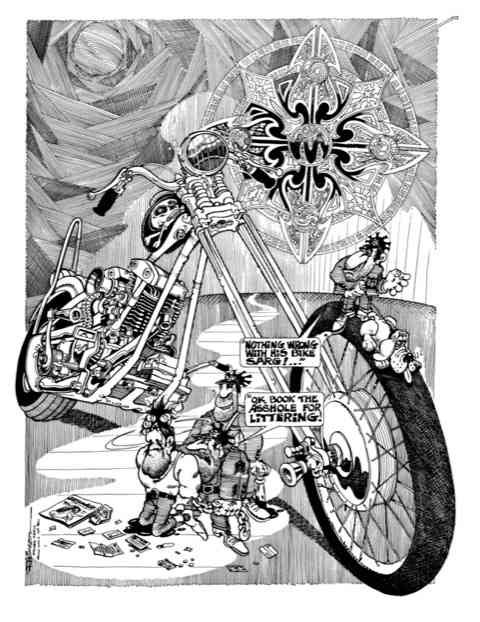
The Master of the Line Drawing for Early Easyriders Magazine
By Ann Robinson Hal2 with illustrations by Hal Robinson
Click here for this enlightening article about an artist only on Bikernet.com
I am writing this because I want people to know about the things Harold (Hal) Robinson went through in his life; things that led up to his greatness as a Cartoonist of the late ‘60s, ‘70s and the ‘80s. Hal Robinson did not have an easy life. However, he called his own shots and did things his way.
He needed this freedom to think and do the magnificent works he created. I loved my husband, Hal Robinson. I loved his drawings also, and I loved him because he was a great human being.
* * * * * * * * * * * *
Click to Visit and Shop for the delightful Hal Robinson Collection only on 5-Ball Racing Shop
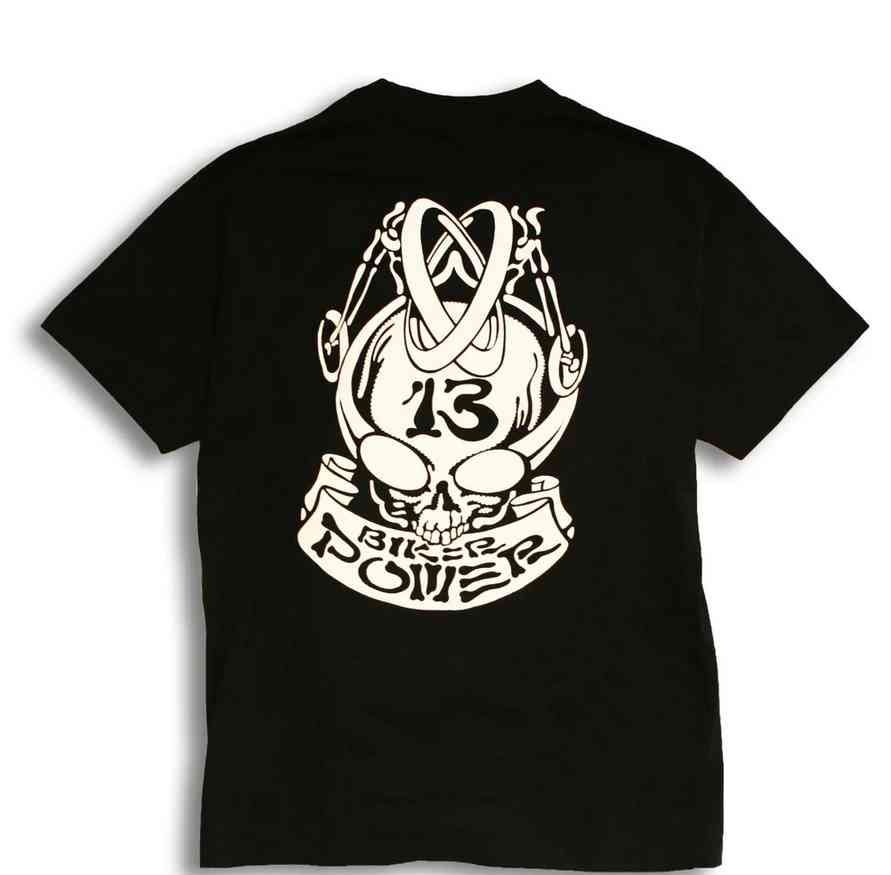
The Life and Times of Hal Robinson
By Bandit |

I am writing this because I want people to know about the things Harold (Hal) Robinson went through in his life; things that led up to his greatness as a Cartoonist of the late ‘60s, ‘70s and the ‘80s. Hal Robinson did not have an easy life. However, he called his own shots and did things his way.
He needed this freedom to think and do the magnificent works he created. I loved my husband, Hal Robinson. I loved his drawings also, and I loved him because he was a great human being. He was born in 1928 and passed away in 1984. He was 54 years old when this happened as a result of a burst appendix and oat cell carcinoma of the lungs.
Hal never liked school and was never told he had any drawing talent. He would rather stay home and take a walk in the woods and observe things he found in nature.He liked reading Boys’ Life. He came from a family of 7 children and it wasn’t easy during his early years.He started working real young and helped out at a place for working girls as a teenager.They were just trying to survive like I was, he told me. He helped the ladies at the house and ran errands for them. What he got for this was a place to sleep and a roof over his head, meals, and chocolate sodas from the soda fountain across the street when he went there on refreshment calls for the ladies. They thought he had cute freckles and liked him a lot. They treated him nice, he said. Later on in his teen years, Hal manned barges in the Bering Sea.

Hal married and had 4 children after serving in the Navy during the Korean War. His wife divorced him because he quit his job at the pulp mill where they lived in Oregon. He had worked there for a while, then had a very close call with a heavy log and decided to quit and left. Then he started doing what he was meant to do which was drawing. He was not supported in this by his family and had difficulty getting enough money to buy the tools he needed like pen, ink, and paper. He was offered a job with Buzza Cardoza Greeting Cards in California after winning a contest for creating new ideas and drawings for greeting cards. Up until then the words on greeting cards were always on the front of the card.
His family was not on board with his dream to be a cartoonist. They wouldn’t come to California with him. He would not leave Oregon without his family. He was finally forced out when the sheriff in town kicked him out of the house without even his wallet. He was picked up for vagrancy because he had no identification.
A few years down the road Hal entered another drawing contest in the mail and won a foldable Schwinn bicycle. He never owned a Chopper or any other kind of motorcycle, but he studied the bikes he drew and the black and white photos sent to him by Easyriders Magazine. He traced many of the bikes first from photos and took off from there.

He put everything he had into his drawings. He wasn’t a biker but loved having fun with the biker life stye in his cartooning. He studied people by drawing them at get-togethers and parties. People loved to have illustrate their picture and have him sign it.

He did sign painting and banners. He painted items featured on grocery store windows, etc. He worked for GTE in the ‘60s and ‘70s as an illustrator for the Yellow Pages.
Hal was a freelance cartoonist for different publications including Easyriders (Paisano Publications). He joined them in 1971 starting with the first issue along with Bandit, who founded this web site. Hal was discovered by a man named Lou Kimzey. Lou admired Hal’s masterpiece caricature of Seal Beach.
Lou asked him to join Easyriders Magazine starting with the first issue. Hal worked from home in Long Beach where Bandit grew up, and then Seal Beach, California, and Bellingham, WA. He mailed his work to Easyriders Magazine and was always accepted without any changes and that was because his works went way beyond great. He was the Cartoon Editor for Easyriders. Then Hal had a severe automobile accident. He was in a coma for a while but finally came out of it. He lived with lots of headaches. Hal said the accident made his drawings even better and more interesting.
I met my husband Harold, or Hal Robinson, for the first time through his far out cartooning in a publication named Trash. It was on a magazine stand in Long Beach in the ‘70s.

I couldn’t believe what I saw!!! His drawings certainly stood out from all the others displayed on the newsstand. They certainly had a definite edge! The panel jokes were hilarious as were the far-out illustrations; but the thing that stood out the most to me was his superlative drawing skills. There were so many flourishes, details, wonderful cross hatching, stippling, finely drawn lines, swirls and turns, hidden pictures that blended so you didn’t always see them the first time, surprises galore. I have been looking at his work for a long time and just found a bird in the cheek of the Hal’s Hog drawing which is posted on Instagram and Facebook.
halrobinsondesigns.com and www.bikernet.com.
I met Harold in person a few years later through a good friend who knew him. Harold knew his worth as a cartoonist and laughed when he told me that he was blackballed by the Cartoonist’s League of America and considered it quite an accomplishment. He too was an Outlaw Cartoonist of his own making with his cutting edge drawings.
Hal was asked to teach Cartooning and Characterization at Cal State Long Beach during the ‘70s through their Free University. They ran out of money for this art effort but Hal was proud to be asked. He loved the thought of being a teacher to others who were interested in his cartooning (plenty were and still are). He was an intriguing person and knew and believed that he had to produce.

Now you know some more things about my husband, Hal Robinson, and some of the events that shaped him into becoming the very unique and exceptional Cartoon Artist he was. People in general loved Hal’s sensitivity, and of course his sense of humor.
Hal created a lot of great works for people to really enjoy, and they have brought much laughter into peoples’ lives. Characters such as Red Rider and Little Beaver, Miraculous Mutha, panel jokes and illustrations depicting the old school biker lifestyle, plus thousands of handmade drawings of customized Harley Choppers, which were shared with bike builders all over the world.

Masterpieces of a towns or cities (originated by Robinson): Seal Beach and Avalon. When I first met Hal, he told me that he was going to live forever! I truly did believe he would live forever and that was 44 years ago! He certainly did know what he was talking about because what he said is happening. He knew the future of his work and he knew his worth. He wanted his work to live on and it is.

–Ann Robinson
(Hal Robinson Archives)
World War II Rider Beatrice Shilling, OBE
By Wayfarer |
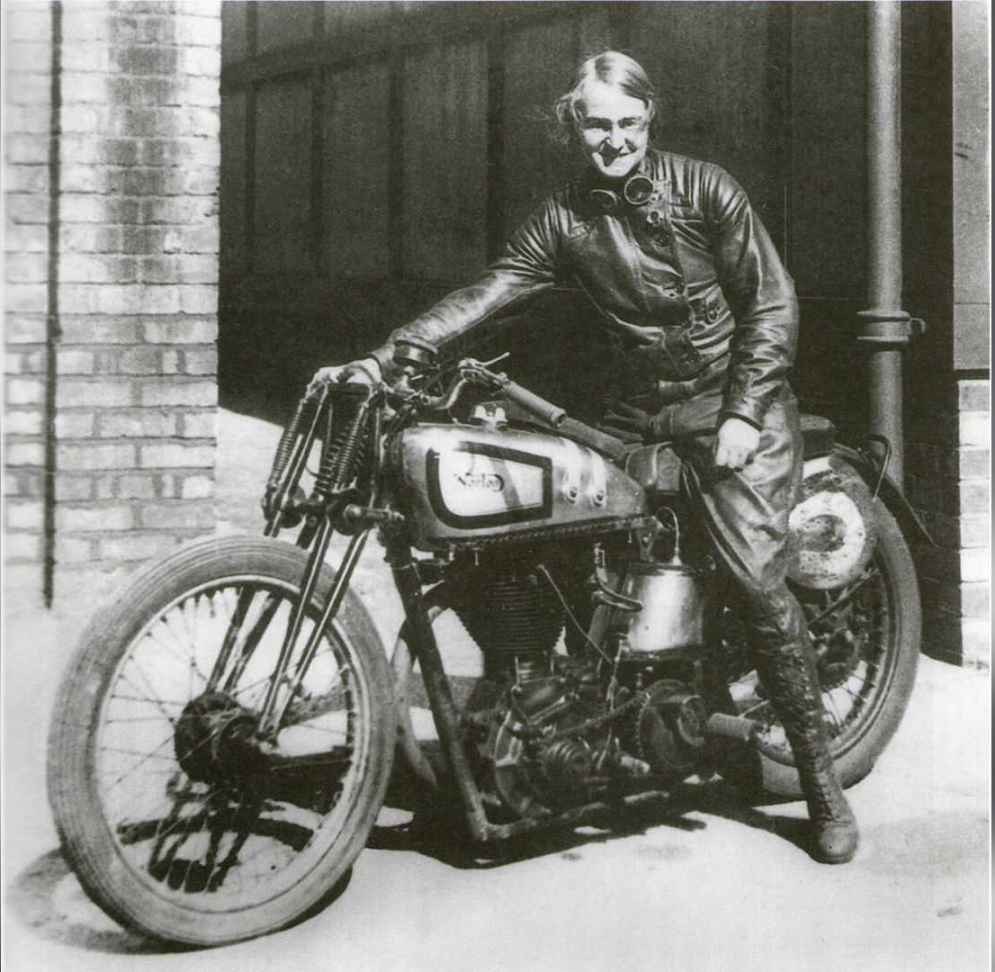
by Jason Marker from https://www.rideapart.com
With a simple, thimble-shaped washer, this pioneering woman gearhead saved the lives of countless RAF pilots in WWII.
During the Battle of Britain, the Royal Air Force discovered a glaring problem with its Rolls-Royce Merlin-powered fighters—the Hawker Hurricane and the Supermarine Spitfire. See, that generation of Merlin was fitted with dual-choke, updraft carburetors built by the S.U. Carburettor Company Limited. These worked just like your regular updraft carb and were great in level flight. Problem was, you see, that fighter planes don’t spend a lot of time in level flight.
Any negative-G maneuvers, such as pitching the nose down sharply in a dive, would cause the carbs to flood and the engine to cut out. Not exactly what you want in your badass, high-po, Nazi-killing fighter. RAF pilots figured out pretty quickly that they could perform a quick half-roll before diving in an attempt to counteract the flooding, but this only worked so well. It also introduced a delay in the RAF boys’ maneuvers that provided ample opportunity for the fuel-injected Luftwaffe fighters—especially Willie Messerschmitt’s legendary BF109—to either blow up the RAF planes or run for it as the situation allowed.
The RAF needed a solution to this problem, and fast. Enter one Beatrice Shilling.
Humble Beginnings and Early Career
Beatrice Shilling was born on March 8, 1909, in Hampshire, and raised in Surrey. Her parents were butcher Henry Shilling and his wife Annie (née Dulake). She was, by all accounts, a peculiar young girl for her time. She was obsessed with Meccano, a model-building system similar to an Erector Set, and even won a prize in a national Meccano-building contest. She spent her pocket money on tools, knives, and pots of glue, and, the fact that most concerns us here at RideApart, bought her first motorcycle at age 14. From that instant, Shilling knew she wanted to be an engineer.
Shilling left secondary school at 17 and apprenticed under legendary electrical engineer, sister badass, and Women’s Engineering Society founder Margaret Partridge. Partridge, who knew quality when she saw it, encouraged Shilling to pursue further engineering education. Following her mentor’s suggestion, Shilling then enrolled at Victoria University of Manchester where she studied electrical engineering—one of only two women enrolled in the program. She graduated with her Bachelor’s in electrical engineering in 1932 and promptly pursued a Master’s Degree in Mechanical Engineering.
Unfortunately for her, Shilling graduated and entered the workforce in the midst of one of Britain’s worst recessions at that point. She kicked around from job to job, struggling to make ends meet, until she landed a spot as a research assistant at the University of Birmingham. There she worked with Professor GF Mucklow studying forced induction, especially supercharging.
In 1936, Shilling was recruited by the Royal Air Force’s research and development arm, the Royal Aircraft Establishment. Her first job at the RAE was as a technical writer working in the Air Ministry’s technical publications department. Her supervisors quickly realized her talents were wasted writing Spitfire owner’s manuals and pilot checklists, and she was transferred to another department where she did R&D on aircraft engines.
On November 1, 1939, she was promoted to Technical Officer in Charge of Carburetor Research and Development (a job I wouldn’t wish on anyone after years of tinkering with carbs myself) and, eventually, to Principal Technical Officer. It was in that role that Shilling developed the answer to the RAF’s stalling Merlin issue. Before we get to that, though, we have to talk about motorcycles.
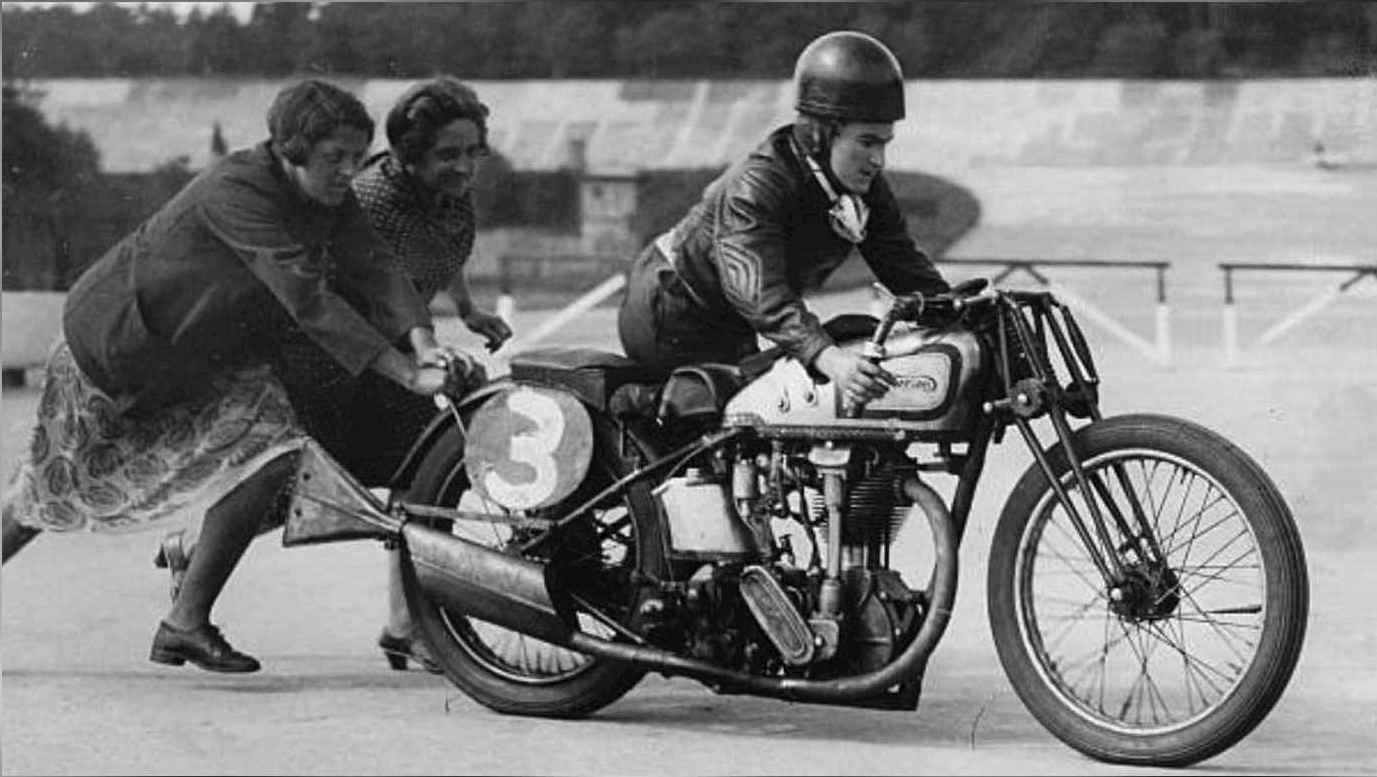
Motorcycles and Motorsport
Now, all that airplane stuff is fascinating, but you all are here to read about motorcycles, right? Don’t worry, I got you covered. As I mentioned earlier, Shilling got her first motorcycle, an unnamed two-stroke job, at the tender age of 14. The first thing she did with it was teach herself how to tear down and rebuild the engine. From there she got into modifying her own bikes, and, like any good gearhead, trying to figure out how to make them go faster.
Throughout the 30s, Shilling raced motorcycles while pursuing her engineering degrees and working for the RAE. She and her all-woman—or nearly all-woman, the information is a little sketchy—team campaigned modified Nortons at various tracks throughout England. In 1934, she set a speed record at Brooklands by lapping the track on a Norton M30 with an average speed of 101.85 mph. She was one of the few riders who’d achieved this, and one of only two women—the other being the formidable racer and adventurer Florence Blenkiron.
For this feat, she was granted the British Motorcycle Racing Club’s prestigious Gold Star Award and bragging rights for the rest of her life. There’s also a story that comes up whenever discussing Shilling’s Brooklands lap that she refused to marry her future husband—fellow racer, rider, RAE employee, and RAF bomber pilot George Naylor—until he matched or beat her lap. Apparently, he eventually did, because the couple was married in 1938.
After The War, Shilling and her husband traded in their motorbikes for racing cars and spent some years tear-assing around the U.K. These cars were, of course, heavily modified by Shilling in her home workshop. Throughout the late-40s and early-50s, Shilling and Naylor raced a lightened 1934 Lagonda Rapier and an Austin-Healy Sebring Sprite. In the 60s, they upgraded to an Elva 200 Formula Junior car. They weren’t the best racers on the circuit, but to paraphrase Les Claypool, they never did win no checkered flags but they never did come in last.
Miss Shilling’s Orifice
So, back to Spitfires. The shortcomings of the Merlin’s carbs were well known, and much gnashing of teeth and rending of garments went on among RAF pilots, technicians, and engineers as they tried to fix the problem. As the RAE’s Chief Technical Officer for Carburetor R&D, Shilling was in the perfect position to do something about the flooding Merlin carbs.
She developed a small device—A brass thimble-like affair with a hole in it that eventually evolved into something like a small washer—that restricted fuel flow through the carburetor. This kept the carbs from flooding under negative g-force maneuvers and made sure the boys in the RAF had all the reliable power they needed constantly on tap. Sir Stanley Hooker, head of supercharger development at Rolls-Royce, called it “Miss Shilling’s Orifice” and the name stuck.
While it may sound odd to our ears here in TYooL 2023, Hooker’s name for Shilling’s restrictor plate is a lot more complimentary than other names people, primarily fellow engineers and RAF brass, had for the device. Most of those—Miss Tilly’s Diaphragm, for example—either referenced birth control or found ways to be derisive. The RAF pilots loved the device, however, especially since now they could keep up with the German fighters without the constant risk of falling out of the sky. Miss Shilling’s Orifice, officially called the RAE Restrictor Plate, stayed in use until Bendix developed the pressure carburetor—an early style of throttle body fuel injection—in 1943.
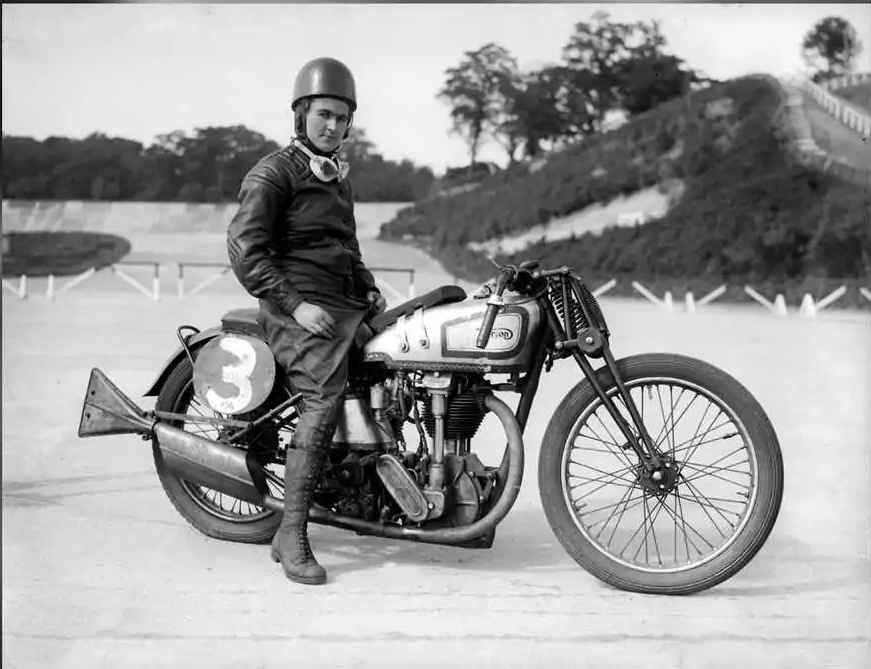
Denouement
For the rest of her life, Beatrice Shilling continued messing around with engines. She retired from the RAE in 1969 and died in 1990 at the age of 81. I could probably write another two or three thousand words about her here, but I’m already pushing it with as long as this story is. There’s so much more to tell about her, and I only scratched the surface.
For example, I glossed over the constant sexism, obstruction, and disrespect she received from colleagues throughout her career. I didn’t get to talk about her work on the Blue Streak Missile, her becoming an Officer of the British Empire (OBE), or a dozen other interesting things about her life. Another time, perhaps.
If you’d like to know more about Beatrice Shilling and her many shining parts (and why wouldn’t you?) you should dig through my sources and follow your nose. If you’re feeling really adventurous, you can try to find a copy of her biography Negative Gravity: A Life of Beatrice Shilling written in 2003 by Mathew Freudenberg. It seems to be long out of print and the only copy I found was offered on Amazon for the eye-watering price of $1,227 Yankee dollars. If you can find a cheaper copy of it anywhere, let me know.

